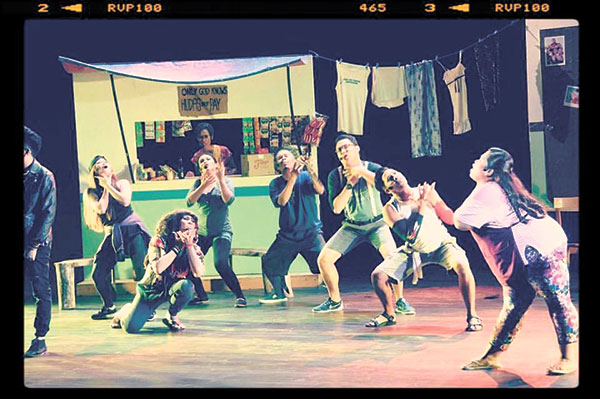Gugmang Giatay: fresh and folksy Bisrock jukebox musical
Review by Karla Quimsing
IF you know Cebuano, you surely understand what Gugmang Giatay means. Until a non-Cebuano speaker asks you to explain it.

Most probably you would use English to translate the statement word for word. Now, it is very simple to give an English word for Gugma. Just say it means Love. Then with some hesitation, proceed by saying that Gugmang is the conjoined word of gugma and nga, and it can roughly mean love is…
Then comes the tricky part. What is the English translation of Giatay? In a daze you would say that its root word atay, means liver. Yet the word giatay describes an outbreak, like a plague that killed all chickens in a coop. Actually, using it to describe Love is sort of weird because love is attributed more to the heart than the liver. This thought leads you to abruptly conclude that it really has no equivalent word in English, this curse word that Cebuanos use not just to describe the fate of chickens. Finally, you come up with the most “accurate” translation you can give: Love is like a curse or a plague. Gugmang Giatay.
Or you can, if you want to sound like an expert, quote the eminent Cebuano historian Resil Mojares in his essay, “Heart and Liver.” He explained that pre-Spanish Filipinos, like their Southeast Asian contemporaries, believed that the atey, ati, hatay, atay or liver is the seat of love. In fact, it is the bodily center of a person’s being where one draws strength, courage, and power. It is the liver and not the heart that is often pronounced when delivering intense emotions such as in the Tagalog word for feeling of grief, dalamhati, which literally means “inside the liver” or luwalhati which expresses utmost joy and literally means “outside the liver.” In Cebuano, one speaks of glowing praise as makapadaku sa atay or enlarges the liver, and makapatibi sa atay or curdles the liver when elucidating a sharp, rending emotion. In the last part of your explanation, you drop the mic by quoting him word by word: Mojares states that it may not sound romantic to describe being love-struck as giatay. Though, come to think of it, being “struck by pestilence” — which is what giatay means— is not at all an inaccurate metaphor for love.
This Cebuano expression of romance in all its richness and complexity has been recurrently interpreted into different forms of art such as poetry, fiction, songs, etc. Yet it was only recently that it was made into a fresh and folksy bisrock jukebox musical. And yes, it carries the title “Gugmang Giatay,” derived from a contemporary classic bisrock (bisaya rock) song by The Ambassadors. The musical captivated its Cebuano audience and had already six stagings to date. The first one was in October 2015 and the most recent was in November 2016.
The love story revolves around the diverse characters living in the Montesclaros boarding house, and its narrative is told from the point of view of Inday, the house help of the landlady. The play opens with Inday spotlighted at the center of the stage, making a call to the modern oracle of love in Cebu, Papa Joe. At this point, the Cebuano audience that is mostly composed of young professionals and students burst into laughter. They all know of course that Papa Joe is a real life radio personality and they must have spent one afternoon listening to the goofy love advices he gives on his show.
As Inday’s story unfolds, it exposes how love obscures the lives of the people living in the boarding house and neighboring sari-sari store. Remember the chicken coop? This very common setting is minimally executed on stage and it provided an effective space that highlights the movements and performance of the actors rather than the stage set. Being a musical, majority of the characters’ dialogues are songs, and what delights the audience is the fusion of Bisrock classics like Missing Filemon’s “Inday,” Cattski’s “Tsaeh,” and Junior Kilat’s “Original Sigbin,” as well as current Vispop songs like “Hahahasula” by Kurt Flick and “Balay ni Mayang” by Kyle Wong and Marianne Dungog into the narrative. The musical is accompanied by a live band with award-winning composer Jude Gitamondoc as the musical director.
One might think that it is just like any other romantic comedy. But would later realize that this is every Bisaya’s romantic comedy. It delves into the layers of romantic relationships: the love/hate attraction of Inday and Undo, the unrequited love of the Inday’s bff Rihanna for Undo, the undying love of the sari-sari store owner (a drunk old lady with a barkada of millennials) for her late husband, the secret love shared by a flamboyant tranny and discreet gay man, and the distant yet hopeful love of the landlady for her OFW husband. All these characters are portrayals of real people that one meets in the streets of Cebu and its familiarity extends to the distinct Bisaya humor in the witty and sarcastic punchlines of their dialogues.
The story finally comes to a resolution with a symbolic earthquake that literally shook the setting and brought the characters to an epiphany. This moment caught the audience off-guard and they altogether howl in amazement. This is the kind of detail that impresses in the sensibility, a magical poetic moment that unpretentiously elevates a work to craft.
“Gugmang Giatay,” the Bisrock Jukebox Musical defines how the romantic Cebuano love, laugh, cry and curse. And that in the midst of laughter, tears, and tagay, there has to be singing.



